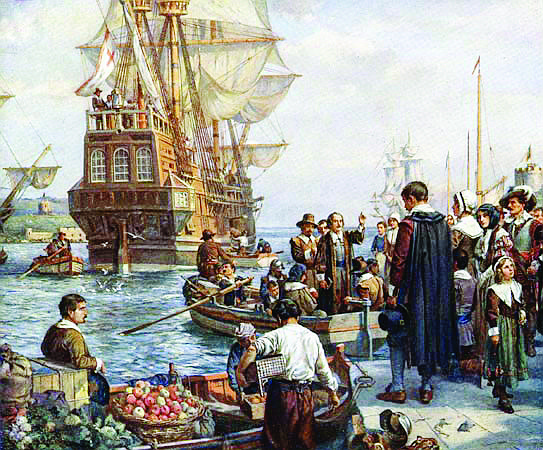- April 23, 2024
-
-
Loading

Loading

The roots of Thanksgiving Day go far deeper than the story of the Pilgrims at Plymouth Colony in 1621. Yes, they were thankful to God for their bountiful harvest and their new-found Indian friends.
But if you can imagine yourself in the shoes of any of the original 102 Pilgrims who sailed for America, a land unknown, and who survived that tumultuous journey, followed by two years of near starvation, your gratitude simply for being alive would put a whole new perspective on Thanksgiving. It was far more than being thankful for a big fall harvest and feast.
Seldom, if ever, do we focus in our history texts on the details that compelled the Pilgrims — also known as Separatists, Puritans and Calvinists — to set sail. The textbooks typically mention they fled religious persecution. But especially today, in this world of widespread and horrific religious persecutions, it’s instructive to remember the details of why the Pilgrims mustered the courage to cross the Unknown Ocean for freedom — for religious freedom.
In his 500-page account of Plymouth Plantation, Gov. William Bradford wrote how his fellow Calvinists in England became “hunted and persecuted on every side, so as their former afflictions were but as flea-bitings in comparison of these which now came upon them.
“For some were taken and clapped up in prison, others had their houses beset and watched night and day, and hardly escaped their hands; and most were faine to flee and leave their houses and habitations, and the means of their livelehood,” Bradford wrote.
After a year of this and meeting in secret to practice their worship of God, they saw “they could no longer continue in this condition,” and “resolved to get over into Holland.” The people of Amsterdam, they had heard, accepted the free practice of religion.
But sailing 200 miles to Amsterdam was no small matter. It was a monumental ordeal. Bradford describes the fear many of the Separatists had of leaving England, as bad as it was, as “a misery worse than death.”
“But these things did not dismay them — for their desires were set on the ways of God and to enjoy his ordinances,” Bradford wrote.
The trip to Holland was horrible for many. Chartered ship operators, once at sea with the Separatists, robbed them; ransacked their belongings; molested many of the women; and then sailed back into the original port and turned over the Separatists to local authorities, who then imprisoned them.
Amazingly, the Separatists didn’t give up. “Some few shrunk at these first conflicts and sharp beginnings,” Bradford wrote, “yet many more came on with fresh courage and greatly animated others. And in the end, notwithstanding all these storms of opposition, they all got over at length.”
For 12 years, the Calvinist-Separatist-Pilgrims lived and practiced their religion in freedom and peace in Leyden, an area within Amsterdam where many of them became weavers.
And then the trouble began again.
Bradford wrote of “Arminians, who greatly molested the whole state”; and university professors and other preachers who began to slander the Pilgrims’ religious practices.
The tormenting rose to such a level that Bradford said some of his neighbors preferred being in prison in England than “this liberty in Holland, with these afflictions.”
Distressed by the increasing abuse, the Separatists’ elders began to look ahead. They believed within a few years they “were fearful either to be entrapped or surrounded by their enemies” and unable to flee.
What’s more, they worried about their children. It was common for them to labor long hours in the mills, “their bodies bowed under the weight.” Many children also fell to the temptations of youthful “licentiousness” and were drawn into “extravagant and dangerous courses,” Bradford wrote. Parents saw “their posterity would be in danger to degenerate and be corrupted.”
At the same time, many of the Separatists looked outward and spoke among their neighbors of “advancing the gospel of the kingdom of Christ in those remote parts of the world,” Bradford wrote.
All three of these influences — persecution, the well-being of their families’ future generations and spreading God’s word — combined to motivate the Pilgrims to seek a new beginning. As they discussed their options, Bradford wrote, “It was answered … the difficulties were many, but not invincible.”
So they set sail to a land unknown. Bradford wrote of “winds so fierce and the seas so high,” and the Mayflower “shroudly shaken” and leaky, raising the constant fear the ship would sink and they would perish at sea.
When they finally stepped on land in the Cape Cod harbor, Bradford wrote, the Pilgrims “fell upon their knees and blessed the God of heaven, who had brought them over the vast and furious ocean and delivered them from all the perils and miseries thereof.”